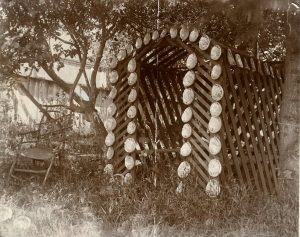by Tonia Hurst
 What do people and sea otters have in common? Well, for one thing, the love of a particular single-shelled mollusk more commonly known as the abalone.
What do people and sea otters have in common? Well, for one thing, the love of a particular single-shelled mollusk more commonly known as the abalone.
What many people don’t realize is how Mendocino became a premier location for abalone fishing, nor do they realize how lucky we are that our wise predecessors conserved this resource for us—their future generation.
Delicious and desirable, abalone grew wherever kelp was available. Pomo people collected and ate it and used the iridescent shells for trade. When the Russians settled at Fort Ross in Sonoma, they inadvertently contributed to a future bounty by hunting the sea otter to the brink of local extinction. By eliminating the abalone’s main predator, the shellfish grew unchecked for several decades before Mendocino was discovered by outsiders.
With a growth rate of about one inch per year and a lifespan of 30 to 50 years, it is easy to imagine local tide pools littered with abalone the size of dinner platters, but the first settlers had no interest in the strange and oozing shellfish.
The Chinese are credited with starting the abalone fishery, recognizing a favorite delicacy from home. They began to collect this and other shellfish in massive quantities, drying and shipping them to San Francisco where they were sent on to China. Soon, fears that the area would be irreparably depleted, combined with a series of punitive laws including the Chinese Exclusion Act of 1882, ended all commercial collection in the intertidal zone.
By the late 1800s, as the Chinese were being pushed out of the market, Japanese fishermen arrived, bringing with them the hard helmet and diving suit. With a continuous air supply, divers could reach the ocean floor, and it was not uncommon for them to collect up to 2300 abalone per day. Sam Ware, a student at Mendocino High School, observed the Japanese encampment at Dark Gulch and wrote that the diver “…takes down with him a net-like basket, which he sends up in about twenty minutes, another being sent down while it is emptied. This holds about all four men can lift into the boat.”
Once hoisted from the water, the abalone were cut from their shells, salted, rinsed, and dried in the sun before being packed and shipped in burlap sacks. Shells were sent to England, where they were made into buttons and other fancies, while others were used as inlay in furniture, their nacre (Mother-of-pearl) finish prized. Abalone pearls, when they were found, were made into pendants and other jewelry.
But, by the fall of 1913, in response to ongoing fears that abalone would disappear in the same manner as the sea otter, new and more stringent local laws ended commercial abalone fishing in Mendocino. While recreational fishing continued—sometimes harvesting enormous quantities—the local abalone fishery was spared the fate of Monterey and other central California coastal towns. And who gets the credit for that intervention? Well, that is the subject of Part II of this series.
The photograph shows an arbor in the Kelley House garden, which had been decorated with abalone shells.